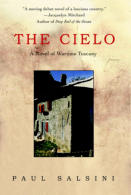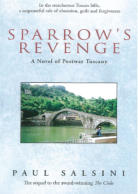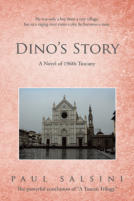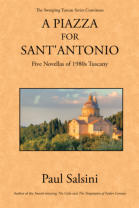Italian American Press
Founded in 2001 Italian and Italian American Authors
Italian and Italian American Books
The Italian American Press
specializes in offering a
selection of books primarily
written by authors of Italian
heritage who write about
Italian American and Italian
culture, heritage, and
history. Many of these
authors are independent
publishers and market their
own books.
Reading stories of Italian
American culture and
history will educate, inform,
and entertain people of all
nationalities.


ABOUT US CONTACT FOR AUTHORS ADVERTISERS



Featured Author
Paul Salsini
The Ghosts of the Garfafnana
Author Interview








What inspired you to write The Ghosts of the Garfagnana?
Ever since I encountered “The Devil’s Bridge,” a beautiful structure
at Borgo a Mozzano, I’ve been intrigued by the Garfagnana area of
Tuscany. It’s fantastically beautiful but also rugged and, yes,
mysterious. I mean, a bridge built by the devil in the Middle Ages?
And caverns where witches brew their potions? And voices and
church bells heard in a village submerged under a lake? So after
writing the last of the six books in “A Tuscan Series,” I decided to
have fun and write some ghost, or at least supernatural stories set
in the Garfagnana.
What is the most important attribute of the book?
I think the span of the book, from the Middle Ages to the present, and all of them
linked to one another, is compelling and informative. Readers will learn about such
wide-ranging things as medieval monastery life, the “flagellants,” the Black Death,
Garibaldi’s army, World War II in Italy, ghosts in theaters and contemporary musical
shows.
Why should someone read it?
For pure enjoyment. I hope it is as much fun for people to read as it was for me to
write.
How did you decide on the time periods and characters for the stories in The
Ghosts of the Garfagnana?
I’ve always wanted to write something set in the Middle Ages so this gave me the
opportunity. I have loved researching that period. In addition to writing about the
pageantry and the art and the history, I could also delve into the Black Death and
the flagellants, and so on. I knew I wanted to have the last story set in
contemporary times so it was fun to write stories for the times in between –
Garibaldi’s army, World War II, etc. The stories may span centuries, but they are
linked.
You have written six books in your Tuscan Series. Can you provide some
background as to why you started writing the series and how the stories
evolved?
I’d never written fiction before but when my cousin Fosca in Italy (she’s now 94) told
me about how she and other people from her village had to flee to a farmhouse in
the hills during the German occupation, I knew I had to write it. So I did a ton of
research and came up with the story in The Cielo: A Novel of Wartime Tuscany.
Oddly, the characters I created stayed in my head so I knew I had to write a sequel,
Sparrow’s Revenge: A Novel of Postwar Tuscany; and then, Dino, a boy born in the
first book and ten years old in the second, inspired me to write Dino’s Story: A
Novel of 1960s Tuscany. After that, the characters took an even stronger hold in my
head, so it was followed by The Temptation of Father Lorenzo: Ten Stories of 1970s
Tuscany, and then A Piazza for Sant’Antonio: Five Novellas of 1980s Tuscany, and
finally, The Fearless Flag Thrower of Lucca: Nine Stories of 1990s Tuscany. I knew
another book would be very sad because some of the characters had gotten to be
old, so I ended the series then. (I still wonder sometimes, about what’s going on
between handsome Father Giancarlo and Anna, the former nun.)
You note that writing The Ghosts of the Garfagnana was fun. How would you
compare your writing and story development in that book to the books in the
Tuscan Series?
With the series, I had written about some of the characters in previous books so it
was a matter of watching, and writing about, their development. There were some
new characters in each and it was fun creating them. With Ghosts of the
Garfagnana, all of the characters were new so it was challenging to see who they
were and what they were doing.
You have also written a children’s book, Stefano and the Christmas Miracles,
and you are working on a sequel. What was the inspiration for the first book
and for the sequel?
Stefano and the Christmas Miracles was inspired by a nativity set I have that was
made by Fontanini, the Italian company. I have some 40 pieces and I always
wondered what this woman with the geese, the boy with the bugle, this man
sharpening knives, and others, were doing at Bethlehem. So I made up a story of a
grandfather telling his grandson, Stefano, stories about each of these. Each story
ends with a miracle. I’ve started working now on sort of a sequel. I have a miniature
medieval village, some 25 pieces – a church, houses, shops, towers, and others.
They are each a couple of inches high and I have them on display in a bookshelf. In
this book, the grandfather is telling Stefano the stories of at least some of the
buildings. I’m having great fun. Hope to have it out next year.
Click on each cover in the Tuscan Series to read an excerpt.
The figurines of the presepio (nativity)
come to life, as grandson and grandfather
share a Christmas tradition.
During
World
War
II,
the
beautiful
hills
of
Tuscany
are
transformed
into
horrific
battlefields.
Inspired
by
the
experiences
of
the
author’s
relatives
…
a
riveting
story
of
courage,
endurance,
and
the
power
of
the
human spirit in the cruelest of times.
…
the
Resistance
fighter
whose
code
name
was
Sparrow
relentlessly
pursues
the
collaborator
of
one
of
the
worst
Nazi
atrocities
in
Italy
during
WWII.
…
an
unforgettable
tale
of
revenge,
retribution,
guilt,
and
finally,
forgiveness.
…
a
coming-of-age
narrative.
Dino
is
in
Florence
studying
art
when
the
devastating
flood
of
1966
ruined
the
city.
In
helping
those
unfortunate
Florentines,
Dino becomes a man.
The
continuing
stories
of
the
characters
in
the
first
three
novels
all
set
in
Florence
and
the beautiful hills of Tuscany.
More
stories
following
the
characters in earlier books.
The
last
book
of
the
series
that
chronicles
the
lives
of
the
people
introduced in earlier books.
